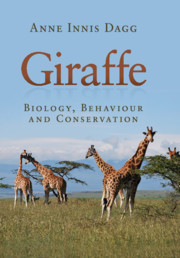Book contents
- Frontmatter
- Dedication
- Contents
- Preface
- Acknowledgements
- List of abbreviations
- 1 Time-line of giraffe
- 2 The giraffe’s environment
- 3 Feeding in the wild
- 4 Social behaviour and populations
- 5 Individual behaviours
- 6 External features
- 7 Anatomy
- 8 Physiology
- 9 Pregnancy, growth, reproduction and aging
- 10 Giraffe in zoos
- 11 Status and conservation of giraffe races
- Appendix Parasites and pathogens
- References
- Index
11 - Status and conservation of giraffe races
Published online by Cambridge University Press: 05 February 2014
- Frontmatter
- Dedication
- Contents
- Preface
- Acknowledgements
- List of abbreviations
- 1 Time-line of giraffe
- 2 The giraffe’s environment
- 3 Feeding in the wild
- 4 Social behaviour and populations
- 5 Individual behaviours
- 6 External features
- 7 Anatomy
- 8 Physiology
- 9 Pregnancy, growth, reproduction and aging
- 10 Giraffe in zoos
- 11 Status and conservation of giraffe races
- Appendix Parasites and pathogens
- References
- Index
Summary
Why races?
Ancestors of the giraffe came into Africa from Asia through what is now Ethiopia, then spread out over the continent. When members of Giraffa camelopardalis evolved, probably in the Pliocene (Churcher, 1978), they spread throughout Africa wherever there were savannahs and open woodlands; their range was restricted only by a lack of trees and bushes from which to forage (although they did not inhabit dense forests) and by too cold weather in the south. Populations of giraffe became isolated in different areas, and over as much as a million or more years developed along different genetic paths leading to distinct subspecies/races. Nine of these have been commonly accepted for giraffe (Lydekker, 1904; Dagg, 1962a, c; Brown et al., 2007), but as we shall see, there are still grey areas.
As men with guns advanced into the interior of Africa in the 1800s, they shot many of these giraffe and gradually took over the best land to farm and build towns and cities which precluded the presence of large wildlife. The races were all undermined to some extent, and some are now on the verge of extinction. Today, the distribution of giraffe is patchy and discontinuous. Some giraffe have been reintroduced to new areas (notably G. c. rothschildi) where it is hoped they will thrive, although occasionally these extralimital areas had never before been inhabited by giraffe, as at the southern edge of the continent.
- Type
- Chapter
- Information
- GiraffeBiology, Behaviour and Conservation, pp. 184 - 208Publisher: Cambridge University PressPrint publication year: 2014



